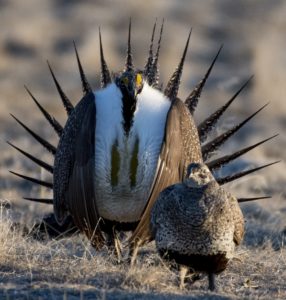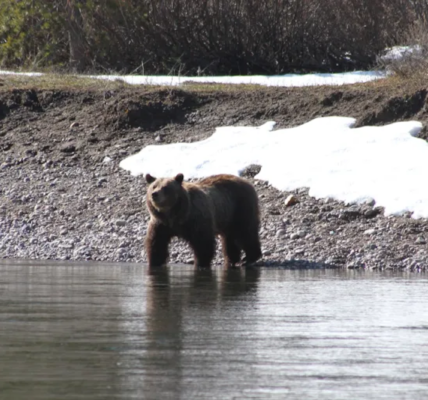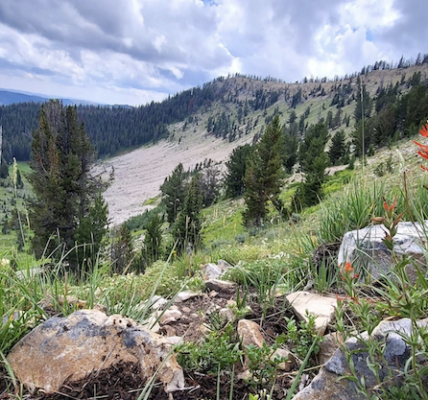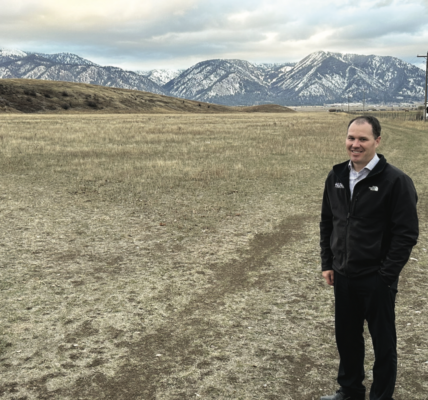
By Mark Davis
Powell Tribune
Via Wyoming News Exchange
POWELL — Greater sage grouse numbers are expected to continue dropping across the West for the fourth year in a row, alarming scientists and conservation officials. It also raises questions of federal management of habitat home to the grouse and more than 350 other species dependent on the sagebrush steppe.
Since the signing of a historic collaborative conservation plan in 2015, state-level data suggest sage-grouse populations have declined 44% on average. Scientists and conservation organizations are sounding the alarm, arguing the Trump administration is continuing to prioritize the use of public land resources over conservation.
On April 6, 22 scientists — including many who participated in the collaboration and sit on state working groups — sent a letter expressing concerns regarding how the federal government is addressing the issue.
“The Department of Interior appears to be ignoring current science, which threatens its federal trust responsibility to conserve and manage our natural resources and may have severe consequences for sage grouse,” they wrote.
Among those signing the letter was former Wyoming Game and Fish Department sage grouse program manager Tom Christiansen. Even after his retirement in 2018, Christiansen continues to volunteer to count leks, sits on a local sage grouse working group and is a strong voice in conservation of the species.
The penned protest comes as hundreds of state and federal employees, private consultants and volunteers dedicate their spring to counting individual grouse at approximately 1,800 occupied leks in Wyoming. Many leks are visited multiple times for an accurate count.
Last year 87% of known occupied leks in the state were visited. Only the most inaccessible sites are missed, often due to weather-related issues.
Wyoming Game and Fish Department sage grouse and sagebrush biologist Leslie Schreiber makes frequent trips to do her part in the count. She recently made a trip down the deeply rutted Red Gulch Road southeast of Greybull.
The area is filled with history, from footprints of dinosaurs 167 million years old, to dozens of tepee rings left by paleo Indians. It’s not hard to imagine the timeline while navigating the dirt road. Very little has changed in the isolated area.
Starting well before sunrise, Schreiber had four leks to visit, but snowdrifts over the sketchy road forced her to miss the most isolated. Finding the leks was fairly easy, as the white chests of strutting males light up like a lightbulb in the early morning hours.
Sage grouse have been here for thousands of years. There is anecdotal evidence the birds were hunted by indigenous Paleo-Indians. Untouched sagebrush steppe may be one of the reasons grouse flourish here, she said.
“It all depends on the quality of the nesting and brood-rearing habitat — the sagebrush habitat surrounding a lek,” Schreiber said. “If you have good habitat, then you have leks that are closer together and more birds on the leks.”
There are several factors to consider when looking into population trends: fragmentation of habitat, abundance of known predators, weather, climate change and invasive species like cheatgrass, that thrive in conditions counterproductive to sagebrush. None of those factors is bigger than changes made to the habitat by man, said Brian Rutledge, Central Flyway policy and conservation strategy adviser for the National Audubon Society.
“We have a loaded situation that we need to be attacking on multiple fronts. And to blame it on weather, or climate change alone is to kid ourselves. Those are contributing factors to an already cancerous situation,” Rutledge said. “They’re like bed sores on a cancer patient. Do you want to deal with them? Yes. But first you want to fight the cancer. And the cancer has been the disruption of the landscape.”
Rutledge was a member of Wyoming’s Sage Grouse Implementation Task Force and has been fighting for responsible leasing practices.
“We’re trying to improve [declining sage grouse populations] and yet the largest landholder in the equation is working very hard to diminish the equation,” he said of the federal government, adding, “We have approximately 50% of the landscape of sagebrush that we had 100 years ago. And they just sold over a million acres for two bucks an acre.”
In the past three years, lease sales for mineral exploration and extraction have ramped up. In 2017, a little more than 390,000 acres were leased to energy companies in Wyoming. By 2019, almost 1.2 million acres were leased in the state. The sales have continued in 2020, much of it protested for taking place in important grouse habitat.
Across the West, more than 5 million acres have been leased since 2017. More than half, 2.75 million acres, were leased in 2019.
The BLM reports that, on average, approximately 60% of the leases will be eventually developed.
“We’ve got to get to a point where we begin to understand the demands of this population, and all those that are dependent on the same habitat,” Rutledge said.
The U.S. Fish and Wildlife Service estimates as many as 16 million sage grouse once inhabited 13 western states and three Canadian provinces. Now, as populations have dwindled 66% since the 1960s — and another 40% in the past four years — there are only about 300,000 left in the U.S. and less than 100 living in the wild in Canada.
Sage grouse are now believed to be extirpated in Nebraska, Arizona and British Columbia. Wyoming is helping in emergency efforts by translocating Wyoming birds to North Dakota to keep the species from becoming extirpated in one of the remaining 11 states — although this year’s transfer was canceled due to social distancing concerns.
Loss of habitat isn’t the only issue challenging sage grouse. One of the unknowns is the extent of loss of the species due to predation.
“It’s fair to say sage grouse have been a part of the western landscape for a long time,” Schreiber said. “It’s important to remember that sage grouse evolved in the sagebrush biome alongside a suite of predators.”
Coyotes have a large impact on sage grouse populations, but have maintained fairly stable populations in Wyoming.
“It’s when any of those predators populations balloon up that sage grouse can be impacted by those predators that are kind of unnaturally increasing,” Schreiber said.
There have been major changes to the population of one of the sage grouse’s main predators: ravens. Populations of the intelligent predator have increased an estimated 400% in the West over the last 40 years, Schreiber said, and “ravens can eat the eggs and small chicks.”
Invasive plant species, like cheatgrass, have also taken a toll. Cheatgrass germinates early, beating out competing natural flora. The plant thrives in disturbed areas, especially taking hold on land used for exploration and areas frequented by visitors. Once germinated, the plant dies and easily catches fire, which helps cheatgrass thrive while being lethal to sagebrush.
The U.S. Department of Agriculture says cheatgrass can maintain dominance for many years on sites where native vegetation has been eliminated or severely reduced by fire.
“When you have those grasses invade sagebrush, it completely turns over, changing the entire vegetation community,” Schreiber said.
It’s a difficult situation, complicated by climate change. Fire seasons are now significantly longer than they have been historically — as much as 78 days longer in some areas.
“It’s clear. Fire and invasive species, primarily cheatgrass, are prime threats to greater sage grouse,” the National Interagency Fire Center said in a special report on fires in sagebrush steppe.
More than 4.6 million acres of sage grouse habitat has burned since 2017, the center reported.
“Sage grouse can’t survive in areas where sagebrush no longer exists, and a sagebrush community may take years to recover from disturbance and some range management practices,” according to the U.S. Fish and Wildlife Service.
It’s a difficult issue, Schreiber said, but “we can’t just throw up our hands and say we can’t do anything about it. That isn’t going to work.”
She remains positive about the state’s position on the seemingly imperiled species. “We’re within the range of variability we’ve seen over the last 20 years.” she said. “So far, we’re not back down to where we were in the mid 1990s. I don’t like to speculate before we get [this year’s count]. However, based on the chick ratio and reproduction we saw last year, it indicates that we should have lower lek numbers this year.”
Christiansen is concerned we could soon be approaching the low numbers of the mid 90s, when sage grouse were being considered for protections under the Endangered Species Act.
“Given the production of chicks last year, we should see another decline this year,” he said. “I’m not going to say it’s going to go below 1995 levels, but I certainly won’t be surprised if it does.”





